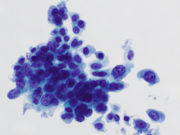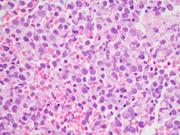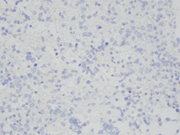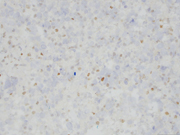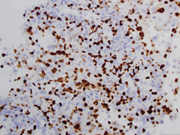Case of the Month ...
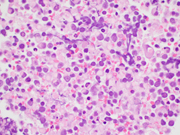
65-year-old female with a 3.3 cm right lower lobe mass abutting the pleura and mediastinal adenopathy. An endobronchial ultrasound-guided fine needle biopsy of a mediastinal lymph node was performed.
Authors
- Merina Rajbhandari, PGY-2, University of Tennessee Health Science Centre
- Swikrity U Baskota, MD, Columbia University Medical Center
Diagnosis & Discussion
click on image for larger version
Figure 3 Figure 4 Figure 5 Figure 6 Images 1-6:
Figure 1: ThinPrep, Papanicolaou Stain, 400x
Figure 2-3: Cell Block, Hematoxylin and Eosin (H&E) Stain, 400x
Figure 4: Pan-cytokeratin, 400x
Figure 5: BRG1, 400x
Figure 6: Ki-67, 400x
Additionally, neoplastic cells were positive for TTF-1 (rare, scattered) and negative for CK7, Napsin-A and p40 (images not shown).
Questions:
- Based on the clinical history, morphology, and immunohistochemistry, which of the following is the most appropriate diagnosis?
- Squamous cell carcinoma
- Adenocarcinoma
- Large cell neuroendocrine carcinoma
- SMARC4-deficient undifferentiated tumor
- SMARCA4 encodes for which protein?
- INI1
- BRG1
- BRM
- ARID1A
Answers:
Question 1: Correct answer is D
Based on the clinical history, morphology, and immunohistochemistry, which of the following is the most appropriate diagnosis?Immunohistochemically, the tumor cells were negative for pan-cytokeratin, and TTF-1 showed scattered rare positivity (not-shown). Additionally, cytokeratin-7, Napsin-A and p40 were negative, and BRG-1 protein was lost. The morphology and staining pattern are most consistent with SMARCA4-deficient undifferentiated tumor (SMARCA4-dUT). This rare tumor with an aggressive behavior presents predominantly as a mediastinal mass in male smokers most often fifth and sixth decades. Morphologically, these tumors exhibit diffuse sheets of dyscohesive tumor cells with predominant epithelioid morphology and prominent nucleoli. Rhabdoid morphology (Figures 2-3), though not necessary, is frequently seen. BRG-1 may be completely lost or show marked reduction. Similarly, cytokeratin and claudin-4 are negative or are present weakly and focally. Synaptophysin, SALL4 and CD34 can be frequently positive whereas TTF-1 and p40 expression is rare and focal.1
Question 2: Correct answer is B
SMARCA4 encodes for which protein?SMARCA4, located on the short arm of chromosome 19, encodes Brahma-related gene-1 (BRG1) protein.2 SMARCA4-deficient tumors were initially described in a variant of pediatric malignant rhabdoid tumor, and since then have been associated with ~20% of tumors of different sites, including small cell carcinoma of the ovary hypercalcemic type, carcinomas of endometrium and gastrointestinal tract as well as melanoma.3
References:
- WHO Classification of Tumors: Thoracic Tumours (5th ed.)// Tumours of the lung// Epithelial tumours // Other epithelial tumours // Thoracic SMARCA4-deficient undifferentiated tumour
- Wilson BG, Roberts CW. SWI/SNF nucleosome remodellers and cancer. Nat Rev Cancer. 2011; 11:481–492.
- Loarer F, Watson S, Pierron G, de Montpreville VT, Ballet S, Firmin N, Auguste A, Pissaloux D, Boyault S, Paindavoine S, Dechelotte PJ, Besse B, Vignaud JM, Brevet M, Fadel E, Richer W, Treilleux I, Masliah-Planchon J, Devouassoux-Shisheboran M, Zalcman G, Allory Y, Bourdeaut F, Thivolet-Bejui F, Ranchere-Vince D, Girard N, Lantuejoul S, Galateau-Sallé F, Coindre JM, Leary A, Delattre O, Blay JY, Tirode F. SMARCA4 inactivation defines a group of undifferentiated thoracic malignancies transcriptionally related to BAF-deficient sarcomas. Nat Genet. 2015 Oct;47(10):1200-5.
